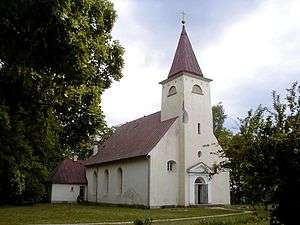Lielvārde
Lielvārde (![]()
Lielvārde | |
|---|---|
Town | |
 Lielvārde Lutheran church | |
 Coat of arms | |
 Lielvārde Location in Latvia | |
| Coordinates: 56°42′N 24°50′E | |
| Country | |
| District | Ogre District |
| Town rights | 1992 |
| Government | |
| • Mayor | Santa Ločmale |
| Area | |
| • Total | 10 km2 (4 sq mi) |
| • Rural territory | 60 km2 (20 sq mi) |
| Population | |
| • Total | 6,708 |
| • Density | 671/km2 (1,740/sq mi) |
| Time zone | UTC+2 (EET) |
| • Summer (DST) | UTC+3 (EEST) |
| Postal code | 507(0-1) |
| Calling code | +371 650 |
| Website | http://www.lielvarde.lv/ |
History

The area was a contact zone between the Finnic Livonians and the Balts, and many prehistoric artifacts have been uncovered there. A Baltic hill-fort named Lennewarden being taken in fief by Albert of Buxhoeveden in 1201 is mentioned in the Chronicle of Henry of Livonia. This site is called Dievukalns (Hill of the Gods) in Latvian. A stone castle was constructed by the Riga diocese in 1229; its ruins are still accessible today.
A parochial school was established when the area was part of Swedish Livonia, but ca. 70% of the population perished in the Great Plague of 1710. The opening of the Riga–Daugavpils Railway in 1861 led to the expansion of the town around the railway station Ringmundhofa later named Rembate. The town was entirely destroyed in World War I but was swiftly rebuilt after Latvia achieved independence.
After the occupation of Latvia and its incorporation into the Soviet Union as the Latvian SSR, Edgars Kauliņš (1903–1979), the local Communist Party secretary, was able to save all of the farmers in the district from deportation during the period of forced collectivization, declaring that there were no kulaks in the area and he would rather be deported himself. In 1948 Kauliņš became the founding chairman of the kolkhoz Lāčplēsis ("The Bear Slayer"), now part of Lielvārde. The kolkhoz became famous for its beer, still brewed in Lielvārde by AS Lāčplēša alus, part of the Scandinavian Royal Unibrew brewing group since 2005. Lielvārde air base was built by the Soviets in 1970; the largest in the Baltic States, it was taken over by the Latvian Air Force in 1994.
Cultural traditions
Lielvārde is renowned as the area that inspired the prominent Latvian poets Auseklis and Andrejs Pumpurs, author of the epic Lāčplēsis (The Bear Slayer, 1888), and for the Lielvārdes josta, a traditional woven belt with 22 ancient symbols. Portions of the belt's design are featured on Latvian banknotes, and its symbolism has inspired many artists and folklore enthusiasts, especially those associated with the pagan revival, dievturība.
References
- Arveds Švābe, ed.: Latvju enciklopēdija. Stockholm: Trīs Zvaigznes, 1952-1953.
- Guntis Zemītis, Ornaments un simbols Latvijas aizvēsturē. Rīga: Latvijas vēstures institūta apgāds, 2004. ISBN 9984-601-20-X
- Ogres rajona pašvaldību vortāls. Retrieved 25. II. 2006.
- James A. Brundage, The Chronicle of Henry of Livonia. Madison: University of Wisconsin Press, 1961.
| Wikimedia Commons has media related to Lielvārde. |
_-83-_p603.jpg)